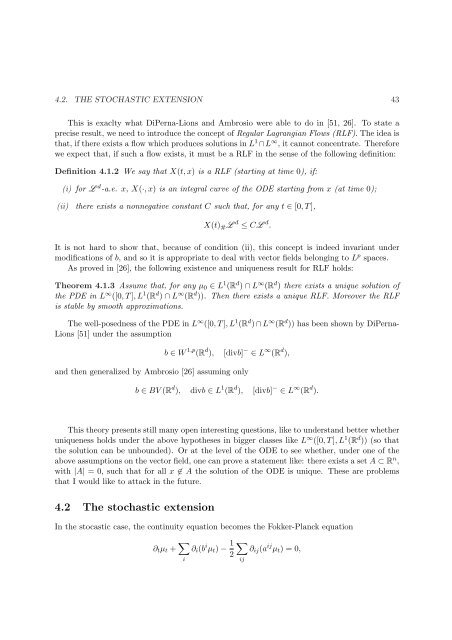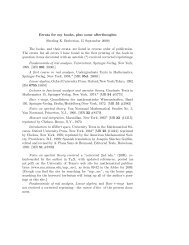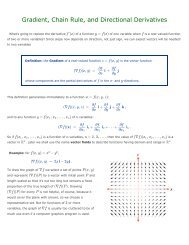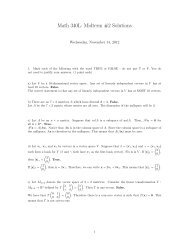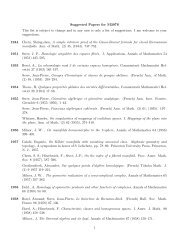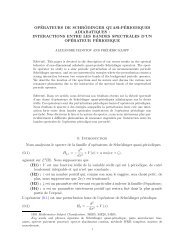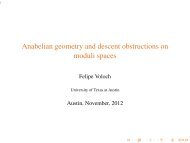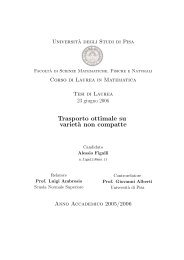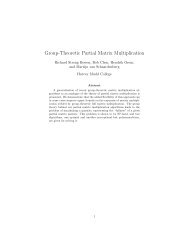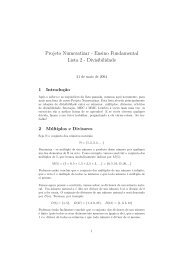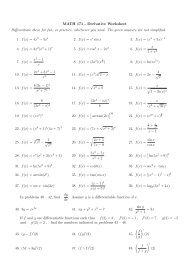Optimal transport, Euler equations, Mather and DiPerna-Lions theories
Optimal transport, Euler equations, Mather and DiPerna-Lions theories
Optimal transport, Euler equations, Mather and DiPerna-Lions theories
You also want an ePaper? Increase the reach of your titles
YUMPU automatically turns print PDFs into web optimized ePapers that Google loves.
4.2. THE STOCHASTIC EXTENSION 43<br />
This is exaclty what <strong>DiPerna</strong>-<strong>Lions</strong> <strong>and</strong> Ambrosio were able to do in [51, 26]. To state a<br />
precise result, we need to introduce the concept of Regular Lagrangian Flows (RLF). The idea is<br />
that, if there exists a flow which produces solutions in L 1 ∩L ∞ , it cannot concentrate. Therefore<br />
we expect that, if such a flow exists, it must be a RLF in the sense of the following definition:<br />
Definition 4.1.2 We say that X(t, x) is a RLF (starting at time 0), if:<br />
(i) for L d -a.e. x, X(·, x) is an integral curve of the ODE starting from x (at time 0);<br />
(ii) there exists a nonnegative constant C such that, for any t ∈ [0, T ],<br />
X(t)#L d ≤ CL d .<br />
It is not hard to show that, because of condition (ii), this concept is indeed invariant under<br />
modifications of b, <strong>and</strong> so it is appropriate to deal with vector fields belonging to L p spaces.<br />
As proved in [26], the following existence <strong>and</strong> uniqueness result for RLF holds:<br />
Theorem 4.1.3 Assume that, for any µ0 ∈ L 1 (R d ) ∩ L ∞ (R d ) there exists a unique solution of<br />
the PDE in L ∞ ([0, T ], L 1 (R d ) ∩ L ∞ (R d )). Then there exists a unique RLF. Moreover the RLF<br />
is stable by smooth approximations.<br />
The well-posedness of the PDE in L ∞ ([0, T ], L 1 (R d ) ∩ L ∞ (R d )) has been shown by <strong>DiPerna</strong>-<br />
<strong>Lions</strong> [51] under the assumption<br />
b ∈ W 1,p (R d ), [divb] − ∈ L ∞ (R d ),<br />
<strong>and</strong> then generalized by Ambrosio [26] assuming only<br />
b ∈ BV (R d ), divb ∈ L 1 (R d ), [divb] − ∈ L ∞ (R d ).<br />
This theory presents still many open interesting questions, like to underst<strong>and</strong> better whether<br />
uniqueness holds under the above hypotheses in bigger classes like L ∞ ([0, T ], L 1 (R d )) (so that<br />
the solution can be unbounded). Or at the level of the ODE to see whether, under one of the<br />
above assumptions on the vector field, one can prove a statement like: there exists a set A ⊂ R n ,<br />
with |A| = 0, such that for all x ∈ A the solution of the ODE is unique. These are problems<br />
that I would like to attack in the future.<br />
4.2 The stochastic extension<br />
In the stocastic case, the continuity equation becomes the Fokker-Planck equation<br />
∂tµt + <br />
i<br />
∂i(b i µt) − 1<br />
2<br />
<br />
∂ij(a ij µt) = 0,<br />
ij


